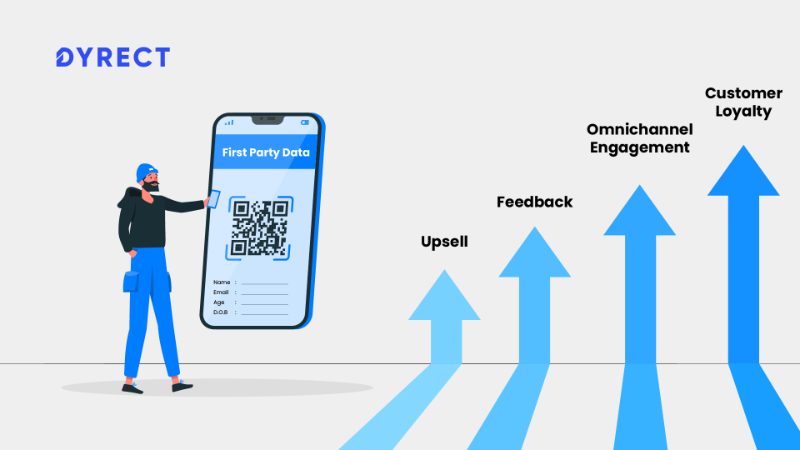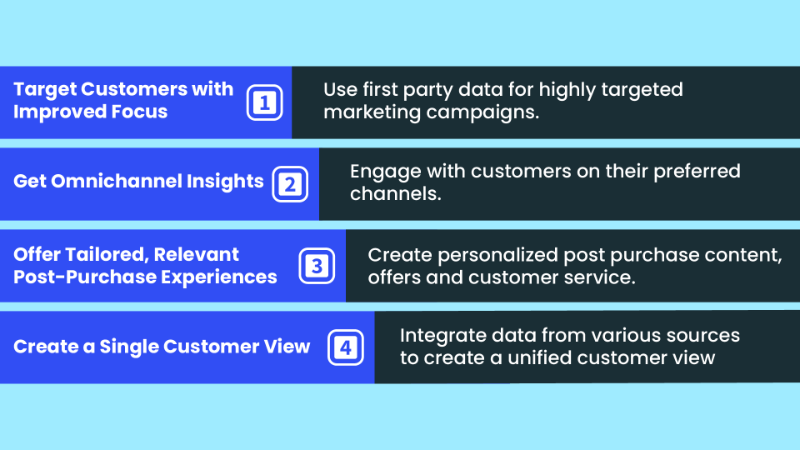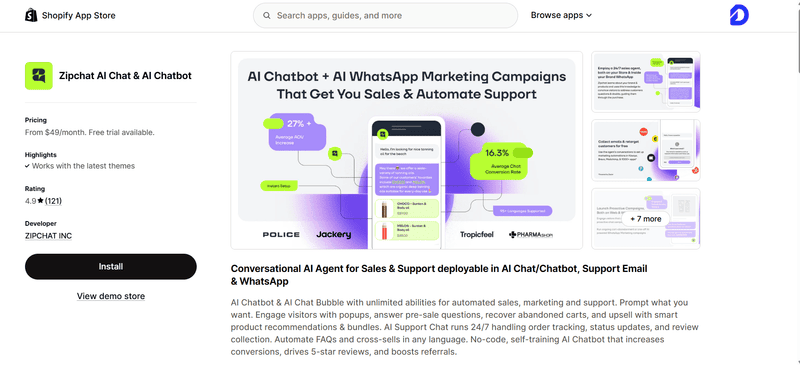
In today's digital age, businesses are constantly seeking ways to connect with their customers on a deeper level. Post-purchase customer engagement has become a crucial aspect of retaining customers and fostering loyalty.
But how can businesses effectively engage with their customers after they make a purchase? The answer lies in leveraging first party data. In this quick guide, we'll explore what first party data is, why it's important, its elements, best practices for collection, and the challenges associated with its use.
What is First Party Data?
First party data refers to the information that a business collects directly from its customers. This data is typically gathered through various touch points such as website interactions, email sign-ups, social media interactions, and purchase history. It is considered the most reliable and valuable type of data as it comes directly from the source, the customers themselves.
Differences Between First, Second and Third Party Data
Before delving into the importance of first party data, it's essential to understand how it differs from second and third party data.
First Party Data
First party data is like the gold standard of customer information. It's the data that a business collects directly from its own interactions with its customers. Imagine it as the treasure trove of insights that a company builds over time from the actions and behaviors of its clientele.
Examples of first party data
Website Forms: When customers fill out contact forms, subscribe to newsletters, or create accounts on your website, the information they provide, such as names, email addresses, and preferences, is considered first party data.
Customer Surveys: Surveys, feedback forms, and post-purchase questionnaires offer valuable insights into customer opinions, satisfaction levels, and preferences.
Purchase History: Records of what customers buy, how often, and at what price point are essential components of first party data. This information helps in tailoring product recommendations and marketing strategies.
Second Party Data
Second party data is essentially someone else's first party data that they willingly share with your business. This data-sharing typically occurs through partnerships, collaborations, or formal agreements, often between two businesses in complementary or related industries.
Examples of Second Party Data
Retailer-Product Manufacturer Collaboration: Imagine a clothing retailer partnering with a shoe manufacturer. The retailer shares its customer data, which includes information on clothing purchases, with the shoe manufacturer. This enables the manufacturer to create targeted marketing campaigns based on the retailer's customer preferences.
The key distinction here is that second party data is voluntarily shared between trusted partners, allowing both parties to benefit from a broader understanding of their shared customer base.
Third Party Data
Third party data, on the other hand, is collected by external sources that are not directly affiliated with your business. This data is often purchased from data providers or brokers who specialize in gathering and selling data.
Examples of third party data
Demographic Data: Information about a person's age, gender, location, income level, and more. This data can be valuable for creating broad customer profiles.
Behavioral Data: Insights into consumer behaviors and preferences, such as online browsing habits, purchase history across various businesses, and social media interactions.
Psychographic Data: Information about consumer values, attitudes, and lifestyles. This data can help in crafting highly targeted marketing messages.
It's important to note that while third party data can provide a broad view of potential customers, it may lack the precision and depth of insights that first party data offers. Additionally, there can be concerns about the accuracy and privacy compliance of third party data sources.
Why is First Party Data Important?
Let’s now take a closer look at why first party data is important.
1. Collected Directly from Customers
First party data is trustworthy because it's obtained directly from customers. This means it reflects their actual behaviors, preferences, and interactions with your brand.
2. Helps Retarget Customers
With first party data, you can create personalized marketing campaigns and retarget customers who have already engaged with your brand, increasing the chances of repeat purchases.
3. Helps Make Informed Decisions Based on Customer Behavior
By analyzing first party data, businesses can gain valuable insights into customer behavior, allowing them to make data-driven decisions regarding product development, marketing strategies, and customer service improvements.
Elements of First Party Data
First party data encompasses a wide range of information, including:
Customer names and contact details
Purchase history and transaction data
Website interactions and browsing behavior
Social media engagement
Customer feedback and reviews
Email interactions
How is First Party Data Best Used?

Let’s now look at some of the best ways to make use of first party data.
1. Target Customers with Improved Focus
One of the primary advantages of first party data is its ability to enable highly targeted marketing campaigns. By analyzing customer behavior, preferences, and past interactions with your brand, you can create personalized messages and product recommendations.
For instance, if a customer frequently buys hiking gear from your outdoor retail store, you can send them offers for new hiking equipment or related accessories. This level of personalization not only increases the chances of conversion but also enhances the customer's perception of your brand.
2. Get Omnichannel Insights
Customers today engage with businesses across various channels, including websites, mobile apps, social media, and in-store. First party data allows you to gain a comprehensive understanding of their journey and preferences by analyzing their interactions across these channels.
By tracking their behavior and preferences throughout the entire customer journey, you can optimize your marketing efforts, ensuring a consistent and seamless experience regardless of the channel they choose.
3. Offer Tailored, Relevant Post-Purchase Experiences
The customer's journey doesn't end with a purchase; it continues with post-purchase experiences. First party data can help you enhance these experiences by providing personalized content, offers, and customer service.
For instance, if a customer has recently purchased a smartphone from your electronics store, you can send them tips on how to maximize its features, recommend compatible accessories, or provide exclusive discounts on related products. This not only encourages repeat purchases but also fosters customer loyalty.
4. Create a Single Customer View
Integrating data from various sources to build a unified customer profile is a key strategy for businesses. This single customer view allows you to maintain consistency in your interactions with customers across different touchpoints.
When a customer contacts your customer support team, for example, they should have access to the same information that the marketing team uses for personalized offers. This ensures a cohesive and satisfying customer experience.
Challenges in Using First Party Data
Brands often fail to make use of the first party data they have at their disposal. Here are some common challenges faced in using first party data.

1. Poor Strategy
Without a well-defined data strategy, collecting and utilizing first party data can be inefficient and ineffective. Businesses should outline clear goals, data collection methods, and data analysis processes to maximize the benefits of their data.
2. Inability to Create a Single Customer View
Integrating data from various sources can be challenging, especially when different departments or systems within a company manage data independently. It's essential to invest in the right tools and technologies to create a unified customer profile.
3. Poor Data Integration
Inefficient data integration processes can lead to data silos, where information is trapped in different parts of the organization. This can hinder the ability to extract meaningful insights from the data. Businesses should prioritize streamlined data integration to break down these silos.
4. Data Decay
First party data is not static; it can become outdated quickly. Customer preferences change, contact information becomes obsolete, and behaviors evolve. Regular data maintenance and updates are essential to ensure data quality and accuracy over time.
First Party Data Collection Best Practices
While there are a variety of tools you could use to collect first party data, such as emails, product registration softwares, surveys and more, here are some first party data collection best practices.
1. Clearly Communicate Data Collection Practices and Obtain Consent
Transparency is key when it comes to collecting first party data. Inform your customers about what data you collect, how it will be used, and whether it will be shared with third parties.
This can be done through clear and concise privacy policies, terms of use, and consent forms. Make sure that users explicitly consent to data collection, ideally through an opt-in mechanism rather than pre-checked boxes. Respect their privacy choices and allow them to modify their preferences easily.
2. Use Data Capture Forms on Your Website and Mobile Apps
Data capture forms are essential tools for collecting first party data. These forms can include registration forms, newsletter sign-ups, contact forms, and feedback surveys.
When designing these forms, keep them user-friendly, concise, and mobile-responsive. Ask for information that is relevant to your business needs and objectives. Avoid overwhelming users with unnecessary fields, as this can discourage them from sharing their data.
3. Encourage Customers to Create Accounts or Profiles
Encouraging customers to create accounts or profiles can be a valuable strategy for collecting first party data. By doing so, you not only gain access to basic contact information but also create opportunities for customers to share preferences, purchase histories, and more.
Offer incentives like personalized recommendations, exclusive discounts, or members-only content to entice users to create accounts. Emphasize the benefits they will receive in return for sharing their information.
4. Implement Analytics Tools to Track User Behavior
To gain deeper insights into customer behavior, it's essential to implement analytics tools on your website and mobile apps. These tools can track user interactions, navigation paths, and engagement metrics.
They provide valuable data on which pages are most visited, which products are frequently viewed, and where users drop off during the checkout process. Analyzing this data allows you to make data-driven decisions, optimize your website, and enhance the user experience.
Ensure that you are fully leveraging the capabilities of your chosen analytics platform and regularly review the collected data to identify trends and areas for improvement.
5. Regularly Update and Clean Your Data to Ensure Accuracy
First party data is dynamic and subject to change. Contact information becomes outdated, preferences shift, and user behavior evolves. To maintain data accuracy and relevance, it's crucial to establish data maintenance processes.
Regularly update your customer profiles, validate email addresses, and remove duplicate or obsolete records. Consider implementing data validation and cleansing tools to automate this process.
Additionally, periodically review and refine your data collection practices to align with changing privacy regulations and user expectations. Compliance with data protection laws such as GDPR and CCPA is essential to build trust with your customers and avoid legal issues.
Get Seamless Access to First Party Data With Dyrect
Very often, SMBs operating in the ecommerce space find it difficult to harvest first party data, largely because they depend on third party sites like eBay or Amazon to sell their products. These ecommerce sites do not give brands access to first party data.
However, we at Dyrect can rectify that, thanks to our industry leading single-click product registration software. Your customers need to simply scan a QR code and sign in to register their purchase, while you get access to first party data. The entire process takes but a few seconds!
In addition, Dyrect can help you build customer retention, gather customer feedback, cross-sell, upsell and much more. To learn more about how Dyrect can get you seamless access to first party data and help you build world-class post purchase customer engagements, book a demo with our team today!


